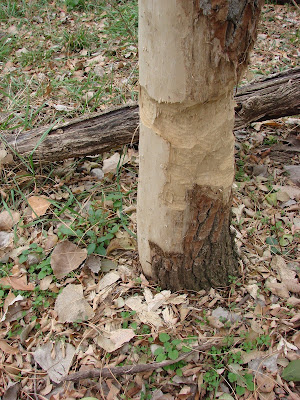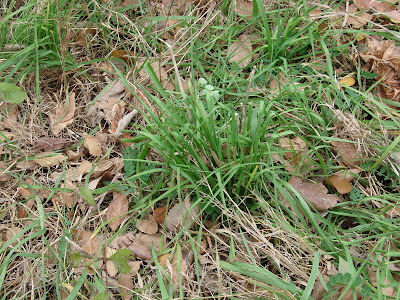Friday, November 30, 2007
Thursday, November 29, 2007
Fallen Tree
I was driving by this area when I remembered there was an interesting tree but I didn't see it. So I got out to look for it.
I photographed this tree in March 2005.
But the tree was not to be seen. It is now on the ground.
Here are the photos I took this Monday morning. 26-Nov-07
Psalm 34:18 "The LORD is near to the brokenhearted And saves those who are crushed in spirit. "
Wednesday, November 28, 2007
Osage Orange Nov 27th Visit
Going back to my favorite Osage orange tree, here is 2 photos taken 27-Nov-07
Here is a link to the tree in the summer of 2006
Job 1:10
" Have You not made a hedge about him and his house and all that he has, on every side? You have blessed the work of his hands, and his possessions have increased in the land."
Missouri State Forest Nursery Now Taking 2008 Orders
Missouri state forest nursery now taking 2008 orders.
A history of the nursery can be read here.
Different assortment of trees, wildlife cover bundle, nut tree bundle, quail cover bundle, pecan variety bundle, etc.
The order form can be accessed here.
A history of the nursery can be read here.
Different assortment of trees, wildlife cover bundle, nut tree bundle, quail cover bundle, pecan variety bundle, etc.
The order form can be accessed here.
Tuesday, November 27, 2007
Fallen Shumard Oak
Here is a photo of Shumard oak. I have not been able to tell the difference between this tree and Northern red oak, unless I can see the buds. Now that the tree is on the ground I ID it as a Shumard oak because of the straw colored buds.
Here you can see the weakness in the bole of the tree that more than likely weakened it which caused it to fall in a storm.
The tree being down made it easy to measure.
Circumference at 4 1/2 feet was 91"
The height was 74'
The canopy was 71' across 18 (for tree points you count 1/4 of canopy)
Total points 183
2 Samuel 3:38 "Then the king said to his servants, "Do you not know that a prince and a great man has fallen this day in Israel?"
Monday, November 26, 2007
Split Tree
Sunday, November 25, 2007
Red Headed Woodpecker
Saw this Redheaded woodpecker on my hike yesterday. The squirrel below chased the woodpecker away when he landed on the squirrel's tree.
This woodpecker made a lot of racket. You can hear its call here. But this recording does not do justice to the racket that the woodpecker I saw yesterday made.
Psalm 20:4,5 "May He grant you your heart's desire,
And fulfill all your counsel!
We will sing for joy over your victory,
And in the name of our God we will set up our banners,
May the LORD fulfill all your petitions."
Saturday, November 24, 2007
Friday, November 23, 2007
Chinquapin Oak, Bur Oak, and Shagbark Hickory Comparrison
I hiked back into some woods I have not seen for a while for lunch. I knew there were some large trees at this one spot. I came across a couple of Bur oaks, Shagbark hickory, Chinquapin oak. There were some smaller Hackberries and American elms. I got some photos of the bark of the large trees and a few photos of leaves for comparison.
This first photo is showing the mature bark of a shag bark hickory. One interesting thing about Shagbark hickory bark is that bats like to sleep under the shag bark.


Here is the bark of young Shagbark hickory. Don't pay attention to the poison ivy vines. The bark is tightly fissured with flat smooth ridges.

this third photo shows the bark of Bur oak. This is a good contrast of a red oak bark with a white oak (group) bark. The white oak (group) has light gray scaly bark.

This photo shows the white bark of Chinquapin oak.

Of the 4 leaves on the log the one on the left is a Bur oak leaf and the third leaf from the left is a Chinquapin oak leaf. The leaf on the right is from the shagbark hickory. The second from the left is a leaf from American elm.
This first photo is showing the mature bark of a shag bark hickory. One interesting thing about Shagbark hickory bark is that bats like to sleep under the shag bark.


Here is the bark of young Shagbark hickory. Don't pay attention to the poison ivy vines. The bark is tightly fissured with flat smooth ridges.

this third photo shows the bark of Bur oak. This is a good contrast of a red oak bark with a white oak (group) bark. The white oak (group) has light gray scaly bark.

This photo shows the white bark of Chinquapin oak.

Of the 4 leaves on the log the one on the left is a Bur oak leaf and the third leaf from the left is a Chinquapin oak leaf. The leaf on the right is from the shagbark hickory. The second from the left is a leaf from American elm.
Thursday, November 22, 2007
White Oak in Intermitant Stream
Photo taken 3-Nov-07

This White oak is in the intermittent stream. You don't usually find White oak in streams. This intermittent stream must not carry water for long.
White oak (Quercus alba) will become the dominate tree in the forest. It probably is called white oak because of the bark. The bark isn't white, but compared to the other barks in the forests it seems whiter.

This White oak is in the intermittent stream. You don't usually find White oak in streams. This intermittent stream must not carry water for long.
White oak (Quercus alba) will become the dominate tree in the forest. It probably is called white oak because of the bark. The bark isn't white, but compared to the other barks in the forests it seems whiter.
Wednesday, November 21, 2007
Cross Timbers
Researching Post oak I came across this site called The Ancient Cross Timbers. The area is dominated by Post oak and upland forest savanna. Cross Timbers area runs from Southeastern Kansas to Central Texas.
Oklahoma Travel Net has a travel log showing what the area looks like for perspective vacationers.
The area is not suitable for normal farm crops. The low economic value has more likely allowed the area to be left for preservation today.
Here is a good site on Cross Timbers ecoregion .
Oklahoma Travel Net has a travel log showing what the area looks like for perspective vacationers.
The area is not suitable for normal farm crops. The low economic value has more likely allowed the area to be left for preservation today.
Here is a good site on Cross Timbers ecoregion .
Tuesday, November 20, 2007
Precarious Boulder
Monday, November 19, 2007
Red Maple / Acer Rubrum
Sunday, November 18, 2007
Beaver Activity

On our walk today we came upon some beaver activity.

Wood chips on top of fallen leaves is indication of recent activity.

Here is a tree they have dropped.

Another tree girdled.

Looking for a beaver lodge did not bring any luck. We did not see any beaver runs either.

My wife pointed out some wild onion.

Not being used to a cold and cloudy hike it was good to get back and have some hot soup with the wild onions.
Saturday, November 17, 2007
Post Oak / Quercus stellata
It's not often that I come across a Post oak. They are listed to be native where I live but I have not seen any for a long time. Yesterday I came across this one. It is a small tree with blocky bark. The leaves are unique in that the lobes form a distinctive cross.
The bark is listed as ashy gray and later in its life becoming blocky. This tree is on a hill which probably does not have good soil and therefore may be shallow before bedrock. My guess this tree is quite old thought it is less then 10" dia. You can see the scale by the leaf near the bowl of the tree.
End buds grouped at the end of the twig is typical for oaks.
Trees of Missouri lists the hairs on the under surface of the leaves as star shaped. I want to return to see those with a hand lens.
The tree is drought resistant and is also slow growing. But it will live up to 300 years or more. It may live where clay is below the surface of the soil about 20" which creates soggy soil in the spring and dry soil in the summer.
The wood is used for railroad ties, fence posts, general construction, firewood, and furniture.
Thursday, November 15, 2007
Pawpaw / Asimina triloba
Wednesday, November 14, 2007
Northern Catalpa / Catalpa speciosa
There was some Catalpa on my property that I had cut down and used for firewood. The wood is light and straight grained. I enjoyed using it for firewood kindling. The neighbors also had some cut down so I had quite a bit of it through the past years. The wood is durable and does not rot as fast as some other logs in my wood pile.
It will grow anywhere but it does best in the bottoms. The tree has been used for fence posts in the past.

I ran across this catalpa tree on a hike recently. One of the main characteristics is the round leaf scar. Inside the leaf scar are bundle scars. Those also are positioned in an oval. A bundle scar are markings on the twig where the vascular bundles had been broken off where it used to be attached.



Light gray/brn bark.
Virginia Tech fact sheet.
It will grow anywhere but it does best in the bottoms. The tree has been used for fence posts in the past.

I ran across this catalpa tree on a hike recently. One of the main characteristics is the round leaf scar. Inside the leaf scar are bundle scars. Those also are positioned in an oval. A bundle scar are markings on the twig where the vascular bundles had been broken off where it used to be attached.



Light gray/brn bark.
Virginia Tech fact sheet.
Monday, November 12, 2007
Shingle Oak / Quercus imbricaria

Shingle oak has unique leaves for oak. They are not lobed but long and narrow. 1-2" wide. This is the first time I have ever seen any fall color in Shingle oak. The leaves hang on throughout the winter, so the tree is easy to identify. But there has never been any color before.
Blue jays have been known to carry the acorns for up to a mile. Shingle oak is a pioneer species that invades pastures and other open ground.
Tree of Heaven / Ailanthus altissima

Tree of heaven buds have a raised leaf scar. The bark of the tree is smooth.

Tree of heaven can thrive in most soil types and has been used in strip mine reclamation. It may grow from sprouting from roots and is a prolific seeder. The tree can withstand drought but not flooding.
Below is a photo of a tree of heaven that I transplanted in the spring of 1993 or 1994. It was knee high then. Now its 33' high with a canopy spread of 25' and a circumference of 29".

Sunday, November 11, 2007
Subscribe to:
Posts (Atom)












